audio MITSUBISHI OUTLANDER PHEV 2016 Owner's Manual (in English)
[x] Cancel search | Manufacturer: MITSUBISHI, Model Year: 2016, Model line: OUTLANDER PHEV, Model: MITSUBISHI OUTLANDER PHEV 2016Pages: 490, PDF Size: 22.02 MB
Page 4 of 490
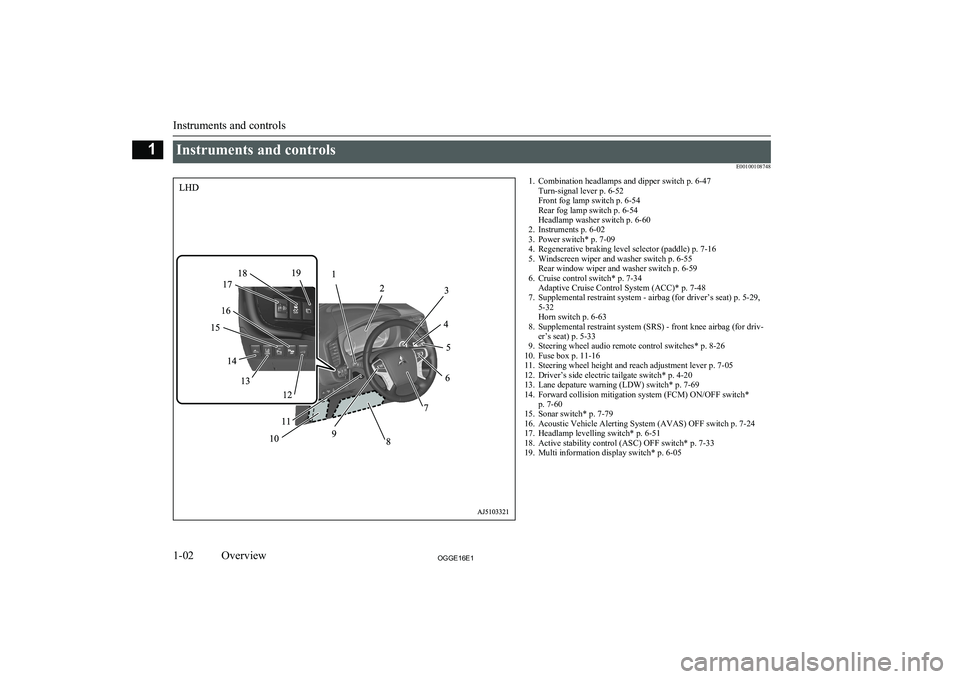
Instruments and controlsE001001087481. Combination headlamps and dipper switch p. 6-47Turn-signal lever p. 6-52
Front fog lamp switch p. 6-54
Rear fog lamp switch p. 6-54
Headlamp washer switch p. 6-60
2. Instruments p. 6-02
3. Power switch* p. 7-09
4. Regenerative braking level selector (paddle) p. 7-16
5. Windscreen wiper and washer switch p. 6-55 Rear window wiper and washer switch p. 6-59
6. Cruise control switch* p. 7-34 Adaptive Cruise Control System (ACC)* p. 7-48
7. Supplemental restraint system - airbag (for driver’s seat) p. 5-29, 5-32
Horn switch p. 6-63
8. Supplemental restraint system (SRS) - front knee airbag (for driv- er’s seat) p. 5-33
9. Steering wheel audio remote control switches* p. 8-26
10. Fuse box p. 11-16
11. Steering wheel height and reach adjustment lever p. 7-05
12. Driver’s side electric tailgate switch* p. 4-20
13. Lane depature warning (LDW) switch* p. 7-69
14. Forward collision mitigation system (FCM) ON/OFF switch* p. 7-60
15. Sonar switch* p. 7-79
16. Acoustic Vehicle Alerting System (AVAS) OFF switch p. 7-24
17. Headlamp levelling switch* p. 6-51
18. Active stability control (ASC) OFF switch* p. 7-33
19. Multi information display switch* p. 6-05
Instruments and controls
1-02OGGE16E1Overview1
Page 5 of 490
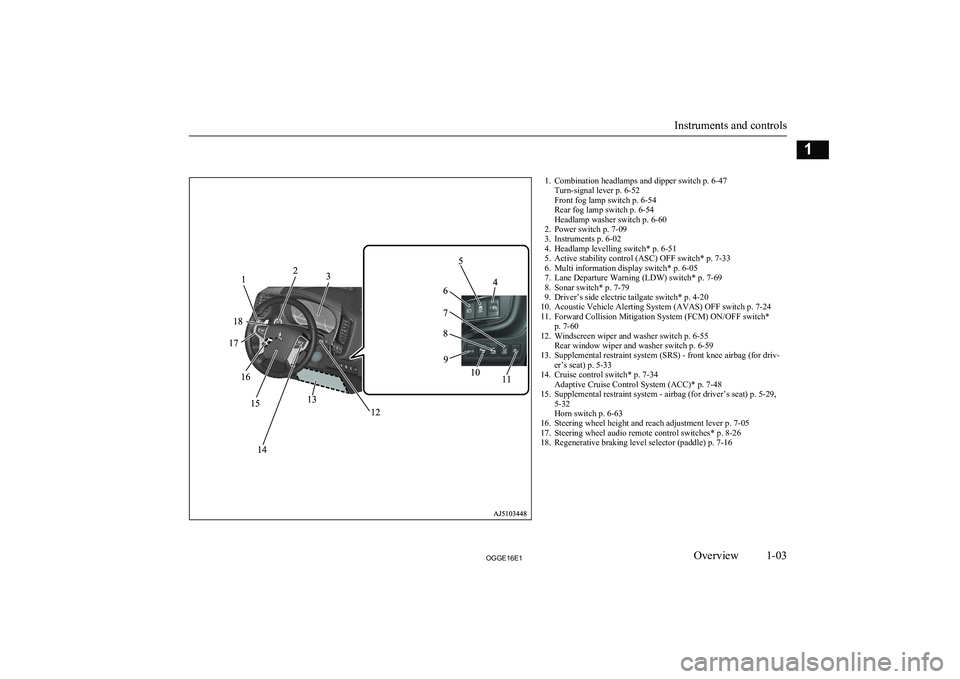
1. Combination headlamps and dipper switch p. 6-47Turn-signal lever p. 6-52
Front fog lamp switch p. 6-54
Rear fog lamp switch p. 6-54
Headlamp washer switch p. 6-60
2. Power switch p. 7-09
3. Instruments p. 6-02
4. Headlamp levelling switch* p. 6-51
5. Active stability control (ASC) OFF switch* p. 7-33
6. Multi information display switch* p. 6-05
7. Lane Departure Warning (LDW) switch* p. 7-69
8. Sonar switch* p. 7-79
9. Driver’s side electric tailgate switch* p. 4-20
10. Acoustic Vehicle Alerting System (AVAS) OFF switch p. 7-24
11. Forward Collision Mitigation System (FCM) ON/OFF switch* p. 7-60
12. Windscreen wiper and washer switch p. 6-55 Rear window wiper and washer switch p. 6-59
13. Supplemental restraint system (SRS) - front knee airbag (for driv- er’s seat) p. 5-33
14. Cruise control switch* p. 7-34 Adaptive Cruise Control System (ACC)* p. 7-48
15. Supplemental restraint system - airbag (for driver’s seat) p. 5-29, 5-32
Horn switch p. 6-63
16. Steering wheel height and reach adjustment lever p. 7-05
17. Steering wheel audio remote control switches* p. 8-26
18. Regenerative braking level selector (paddle) p. 7-16
Instruments and controls
1-03OGGE16E1Overview1
Page 6 of 490
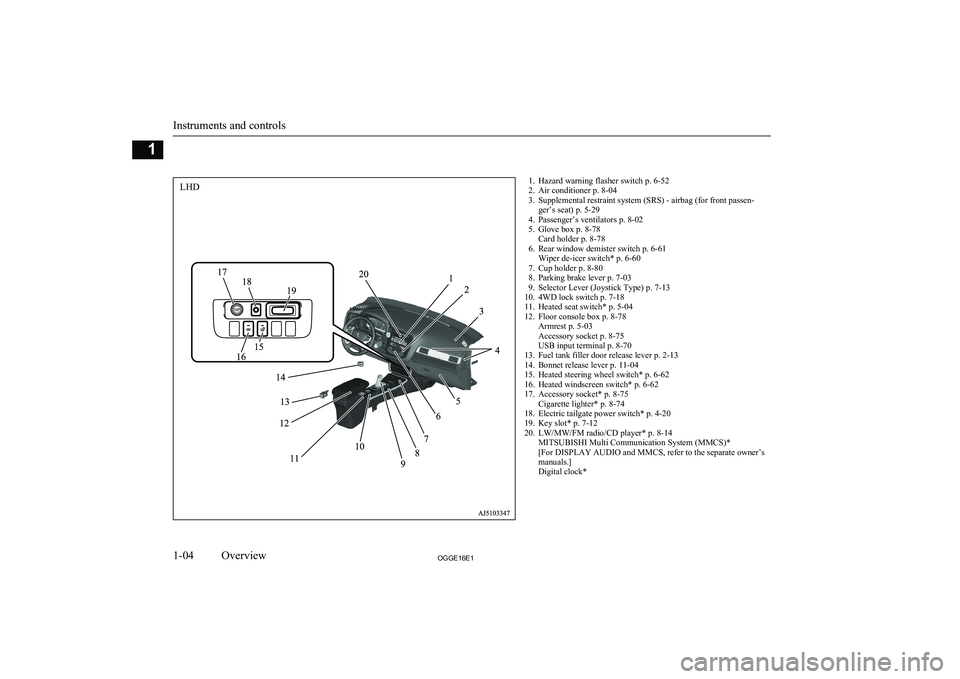
1. Hazard warning flasher switch p. 6-52
2. Air conditioner p. 8-04
3. Supplemental restraint system (SRS) - airbag (for front passen- ger’s seat) p. 5-29
4. Passenger’s ventilators p. 8-02
5. Glove box p. 8-78 Card holder p. 8-78
6. Rear window demister switch p. 6-61 Wiper de-icer switch* p. 6-60
7. Cup holder p. 8-80
8. Parking brake lever p. 7-03
9. Selector Lever (Joystick Type) p. 7-13
10. 4WD lock switch p. 7-18
11. Heated seat switch* p. 5-04
12. Floor console box p. 8-78 Armrest p. 5-03
Accessory socket p. 8-75
USB input terminal p. 8-70
13. Fuel tank filler door release lever p. 2-13
14. Bonnet release lever p. 11-04
15. Heated steering wheel switch* p. 6-62
16. Heated windscreen switch* p. 6-62
17. Accessory socket* p. 8-75 Cigarette lighter* p. 8-74
18. Electric tailgate power switch* p. 4-20
19. Key slot* p. 7-12
20. LW/MW/FM radio/CD player* p. 8-14 MITSUBISHI Multi Communication System (MMCS)*
[For DISPLAY AUDIO and MMCS, refer to the separate owner’s
manuals.]
Digital clock*
Instruments and controls
1-04OGGE16E1Overview1LHD
Page 7 of 490
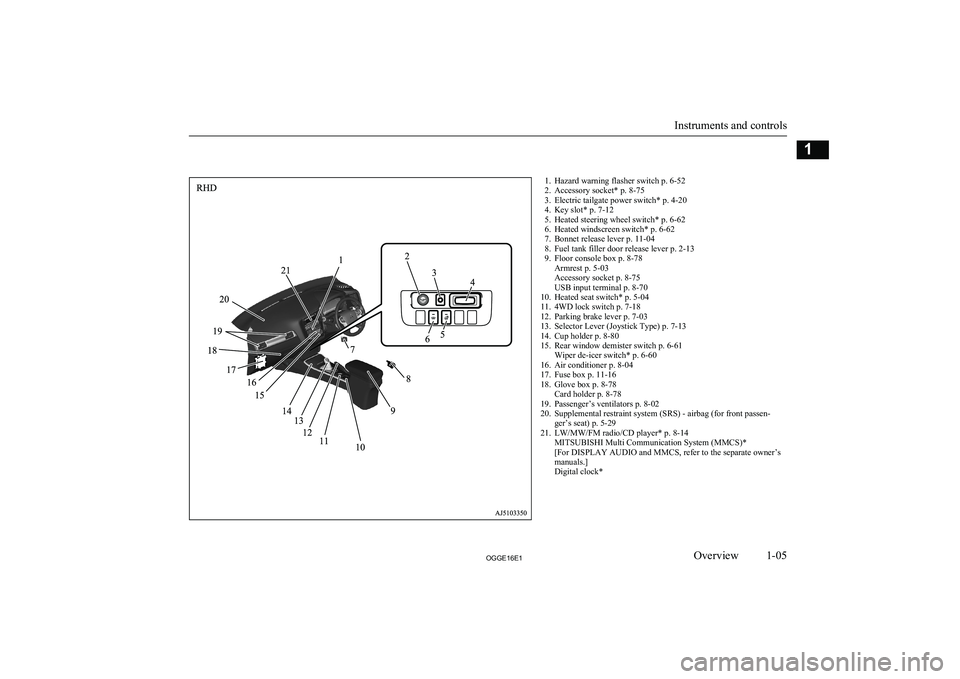
1. Hazard warning flasher switch p. 6-52
2. Accessory socket* p. 8-75
3. Electric tailgate power switch* p. 4-20
4. Key slot* p. 7-12
5. Heated steering wheel switch* p. 6-62
6. Heated windscreen switch* p. 6-62
7. Bonnet release lever p. 11-04
8. Fuel tank filler door release lever p. 2-13
9. Floor console box p. 8-78 Armrest p. 5-03
Accessory socket p. 8-75
USB input terminal p. 8-70
10. Heated seat switch* p. 5-04
11. 4WD lock switch p. 7-18
12. Parking brake lever p. 7-03
13. Selector Lever (Joystick Type) p. 7-13
14. Cup holder p. 8-80
15. Rear window demister switch p. 6-61 Wiper de-icer switch* p. 6-60
16. Air conditioner p. 8-04
17. Fuse box p. 11-16
18. Glove box p. 8-78 Card holder p. 8-78
19. Passenger’s ventilators p. 8-02
20. Supplemental restraint system (SRS) - airbag (for front passen- ger’s seat) p. 5-29
21. LW/MW/FM radio/CD player* p. 8-14 MITSUBISHI Multi Communication System (MMCS)*
[For DISPLAY AUDIO and MMCS, refer to the separate owner’s
manuals.]
Digital clock*
Instruments and controls
1-05OGGE16E1Overview1
Page 37 of 490
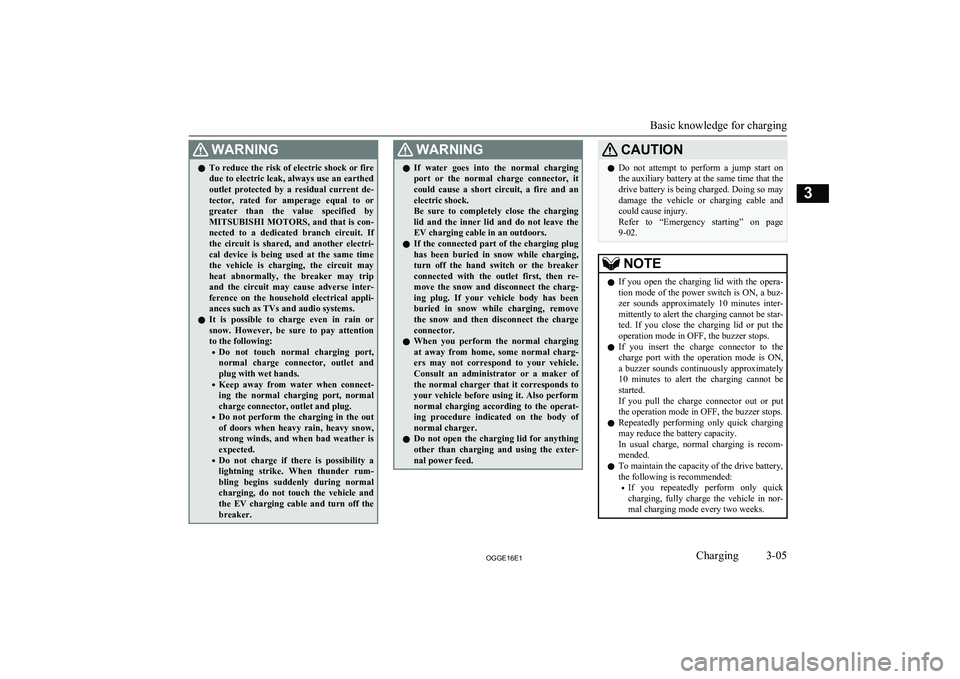
WARNINGlTo reduce the risk of electric shock or fire
due to electric leak, always use an earthed
outlet protected by a residual current de-
tector, rated for amperage equal to or greater than the value specified by MITSUBISHI MOTORS , and that is con-
nected to a dedicated branch circuit. If
the circuit is shared, and another electri- cal device is being used at the same time
the vehicle is charging, the circuit may heat abnormally, the breaker may trip
and the circuit may cause adverse inter-
ference on the household electrical appli- ances such as TVs and audio systems.
l It is possible to charge even in rain or
snow. However, be sure to pay attention
to the following:
• Do not touch normal charging port,
normal charge connector, outlet and plug with wet hands.
• Keep away from water when connect-
ing the normal charging port, normal
charge connector, outlet and plug.
• Do not perform the charging in the out
of doors when heavy rain, heavy snow, strong winds, and when bad weather is
expected.
• Do not charge if there is possibility a
lightning strike. When thunder rum- bling begins suddenly during normal
charging, do not touch the vehicle and the EV charging cable and turn off the
breaker.WARNINGl If water goes into the normal charging
port or the normal charge connector, itcould cause a short circuit, a fire and an electric shock.
Be sure to completely close the charging lid and the inner lid and do not leave the
EV charging cable in an outdoors.
l If the connected part of the charging plug
has been buried in snow while charging,
turn off the hand switch or the breaker
connected with the outlet first, then re- move the snow and disconnect the charg-
ing plug. If your vehicle body has been buried in snow while charging, remove
the snow and then disconnect the charge connector.
l When you perform the normal charging
at away from home, some normal charg-ers may not correspond to your vehicle.
Consult an administrator or a maker of
the normal charger that it corresponds to your vehicle before using it. Also perform
normal charging according to the operat-
ing procedure indicated on the body of normal charger.
l Do not open the charging lid for anything
other than charging and using the exter-
nal power feed.CAUTIONl Do not attempt to perform a jump start on
the auxiliary battery at the same time that the
drive battery is being charged. Doing so may
damage the vehicle or charging cable and
could cause injury.
Refer to “Emergency starting” on page 9-02.NOTEl If you open the charging lid with the opera-
tion mode of the power switch is ON, a buz- zer sounds approximately 10 minutes inter-mittently to alert the charging cannot be star- ted. If you close the charging lid or put theoperation mode in OFF, the buzzer stops.
l If you insert the charge connector to the
charge port with the operation mode is ON,
a buzzer sounds continuously approximately
10 minutes to alert the charging cannot be started.
If you pull the charge connector out or put the operation mode in OFF, the buzzer stops.
l Repeatedly performing only quick charging
may reduce the battery capacity.
In usual charge, normal charging is recom-
mended.
l To maintain the capacity of the drive battery,
the following is recommended:
• If you repeatedly perform only quick
charging, fully charge the vehicle in nor-
mal charging mode every two weeks.
Basic knowledge for charging
3-05OGGE16E1Charging3
Page 45 of 490
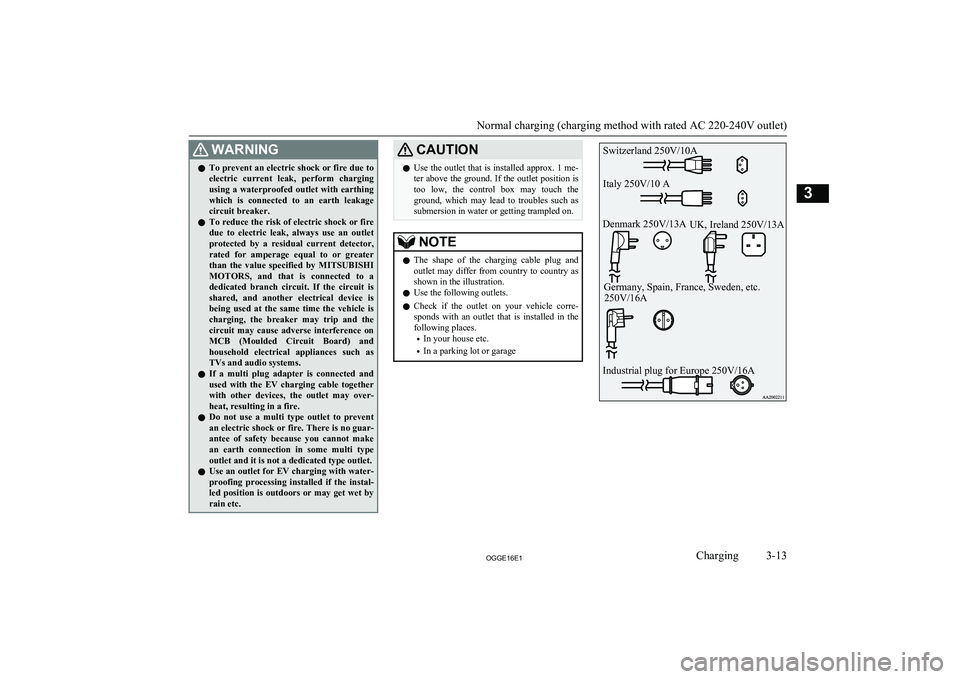
WARNINGlTo prevent an electric shock or fire due to
electric current leak, perform charging
using a waterproofed outlet with earthing
which is connected to an earth leakage circuit breaker.
l To reduce the risk of electric shock or fire
due to electric leak, always use an outlet
protected by a residual current detector, rated for amperage equal to or greater than the value specified by MITSUBISHI
MOTORS , and that is connected to a
dedicated branch circuit. If the circuit is shared, and another electrical device is
being used at the same time the vehicle is charging, the breaker may trip and thecircuit may cause adverse interference on
MCB (Moulded Circuit Board) and
household electrical appliances such as TVs and audio systems.
l If a multi plug adapter is connected and
used with the EV charging cable together with other devices, the outlet may over- heat, resulting in a fire.
l Do not use a multi type outlet to prevent
an electric shock or fire. There is no guar- antee of safety because you cannot make
an earth connection in some multi type outlet and it is not a dedicated type outlet.
l Use an outlet for EV charging with water-
proofing processing installed if the instal- led position is outdoors or may get wet by
rain etc.CAUTIONl Use the outlet that is installed approx. 1 me-
ter above the ground. If the outlet position is
too low, the control box may touch the ground, which may lead to troubles such as
submersion in water or getting trampled on.NOTEl The shape of the charging cable plug and
outlet may differ from country to country as shown in the illustration.
l Use the following outlets.
l Check if the outlet on your vehicle corre-
sponds with an outlet that is installed in the
following places.
• In your house etc.
• In a parking lot or garage
Normal charging (charging method with rated AC 220-240V outlet)
3-13OGGE16E1Charging3 Denmark 250V/13AUK, Ireland 250V/13A
Germany, Spain, France, Sweden, etc. 250V/16A
Industrial plug for Europe 250V/16A
Switzerland 250V/10A Italy 250V/10 A
Page 46 of 490
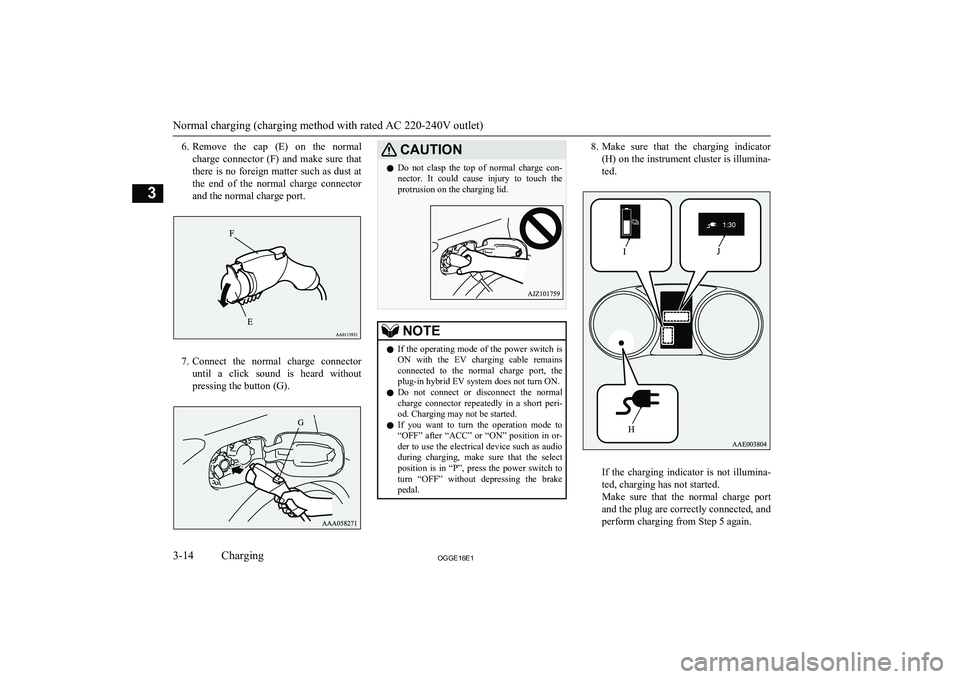
6.Remove the cap (E) on the normal
charge connector (F) and make sure that
there is no foreign matter such as dust at
the end of the normal charge connector and the normal charge port.
7. Connect the normal charge connector
until a click sound is heard without pressing the button (G).
CAUTIONl Do not clasp the top of normal charge con-
nector. It could cause injury to touch the protrusion on the charging lid.NOTEl If the operating mode of the power switch is
ON with the EV charging cable remains
connected to the normal charge port, the
plug-in hybrid EV system does not turn ON.
l Do not connect or disconnect the normal
charge connector repeatedly in a short peri- od. Charging may not be started.
l If you want to turn the operation mode to
“OFF” after “ACC” or “ON” position in or-
der to use the electrical device such as audio
during charging, make sure that the select position is in “P”, press the power switch toturn “OFF” without depressing the brakepedal.8. Make sure that the charging indicator
(H) on the instrument cluster is illumina-
ted.
If the charging indicator is not illumina-
ted, charging has not started.
Make sure that the normal charge port
and the plug are correctly connected, and
perform charging from Step 5 again.
Normal charging (charging method with rated AC 220-240V outlet)
3-14OGGE16E1Charging3
Page 60 of 490
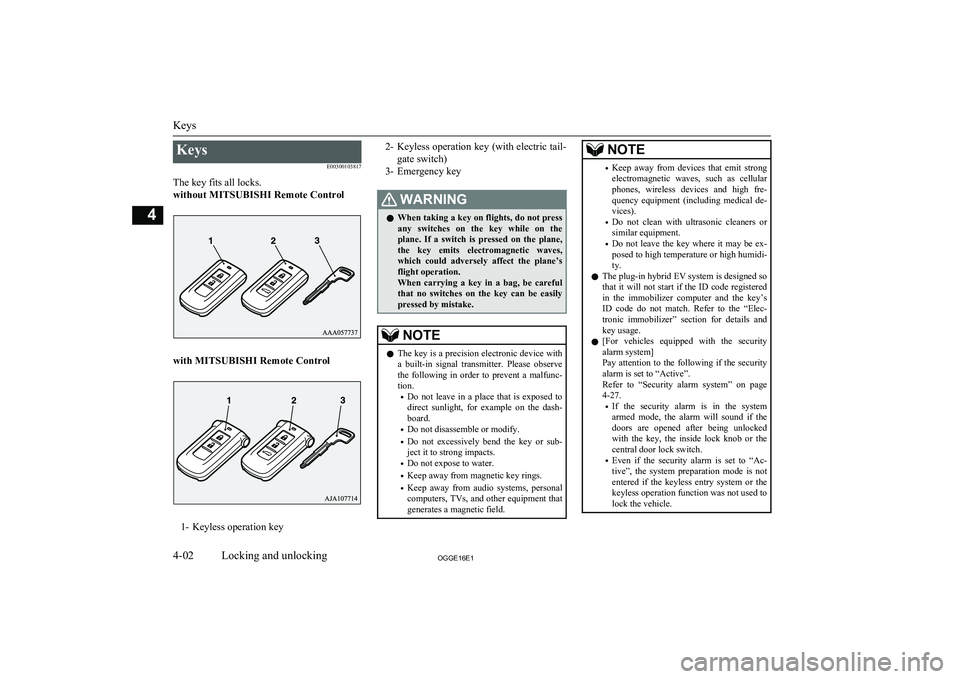
KeysE00300103817
The key fits all locks.
without MITSUBISHI Remote Control
with MITSUBISHI Remote Control
1- Keyless operation key
2- Keyless operation key (with electric tail-
gate switch)
3- Emergency keyWARNINGl When taking a key on flights, do not press
any switches on the key while on the plane. If a switch is pressed on the plane,
the key emits electromagnetic waves, which could adversely affect the plane’s flight operation.
When carrying a key in a bag, be careful that no switches on the key can be easily
pressed by mistake.NOTEl The key is a precision electronic device with
a built-in signal transmitter. Please observe
the following in order to prevent a malfunc- tion.
• Do not leave in a place that is exposed to
direct sunlight, for example on the dash- board.
• Do not disassemble or modify.
• Do not excessively bend the key or sub-
ject it to strong impacts.
• Do not expose to water.
• Keep away from magnetic key rings.
• Keep away from audio systems, personal
computers, TVs, and other equipment that generates a magnetic field.NOTE• Keep away from devices that emit strong
electromagnetic waves, such as cellular
phones, wireless devices and high fre- quency equipment (including medical de-
vices).
• Do not clean with ultrasonic cleaners or
similar equipment.
• Do not leave the key where it may be ex-
posed to high temperature or high humidi- ty.
l The plug-in hybrid EV system is designed so
that it will not start if the ID code registered
in the immobilizer computer and the key’s ID code do not match. Refer to the “Elec-
tronic immobilizer” section for details and key usage.
l [For vehicles equipped with the security
alarm system]
Pay attention to the following if the security
alarm is set to “Active”.
Refer to “Security alarm system” on page 4-27.
• If the security alarm is in the system
armed mode, the alarm will sound if the
doors are opened after being unlocked with the key, the inside lock knob or the
central door lock switch.
• Even if the security alarm is set to “Ac-
tive”, the system preparation mode is not entered if the keyless entry system or thekeyless operation function was not used to
lock the vehicle.
Keys
4-02OGGE16E1Locking and unlocking4
Page 111 of 490
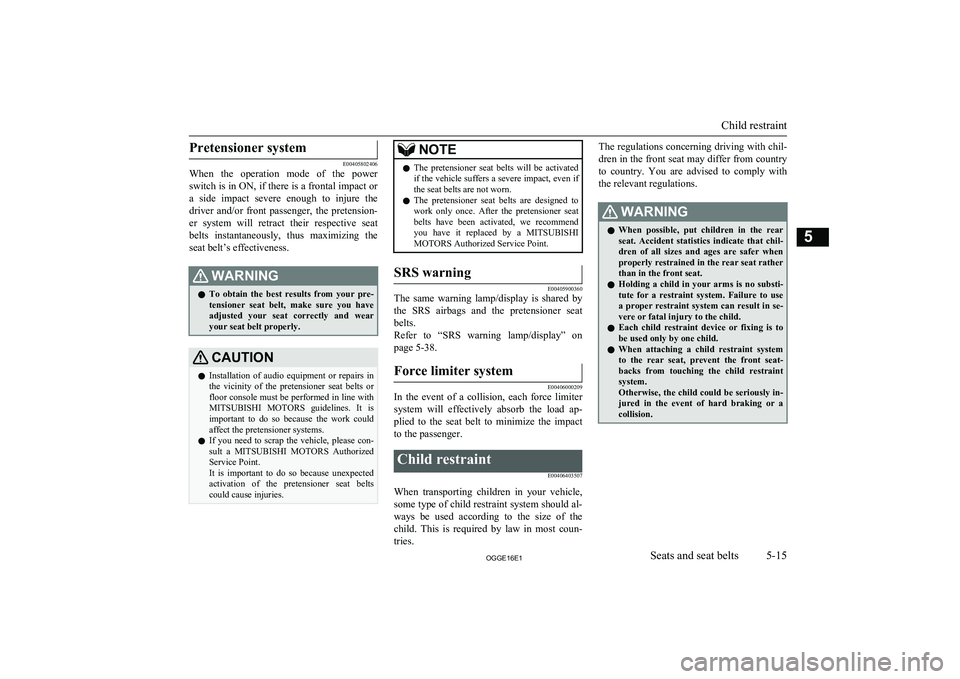
Pretensioner system
E00405802406
When the operation mode of the power
switch is in ON, if there is a frontal impact or a side impact severe enough to injure the
driver and/or front passenger, the pretension- er system will retract their respective seat
belts instantaneously, thus maximizing the seat belt’s effectiveness.
WARNINGl To obtain the best results from your pre-
tensioner seat belt, make sure you have adjusted your seat correctly and wear your seat belt properly.CAUTIONl Installation of audio equipment or repairs in
the vicinity of the pretensioner seat belts or
floor console must be performed in line with MITSUBISHI MOTORS guidelines. It is
important to do so because the work could affect the pretensioner systems.
l If you need to scrap the vehicle, please con-
sult a MITSUBISHI MOTORS Authorized
Service Point.
It is important to do so because unexpected activation of the pretensioner seat belts
could cause injuries.NOTEl The pretensioner seat belts will be activated
if the vehicle suffers a severe impact, even if the seat belts are not worn.
l The pretensioner seat belts are designed to
work only once. After the pretensioner seat
belts have been activated, we recommend you have it replaced by a MITSUBISHI
MOTORS Authorized Service Point.SRS warning
E00405900360
The same warning lamp/display is shared by
the SRS airbags and the pretensioner seat
belts.
Refer to “SRS warning lamp/display” on page 5-38.
Force limiter system
E00406000209
In the event of a collision, each force limitersystem will effectively absorb the load ap- plied to the seat belt to minimize the impact
to the passenger.
Child restraint
E00406403507
When transporting children in your vehicle,some type of child restraint system should al-
ways be used according to the size of the child. This is required by law in most coun-
tries.
The regulations concerning driving with chil-
dren in the front seat may differ from country
to country. You are advised to comply with the relevant regulations.WARNINGl When possible, put children in the rear
seat. Accident statistics indicate that chil- dren of all sizes and ages are safer when
properly restrained in the rear seat rather than in the front seat.
l Holding a child in your arms is no substi-
tute for a restraint system. Failure to use
a proper restraint system can result in se- vere or fatal injury to the child.
l Each child restraint device or fixing is to
be used only by one child.
l When attaching a child restraint system
to the rear seat, prevent the front seat- backs from touching the child restraintsystem.
Otherwise, the child could be seriously in-
jured in the event of hard braking or a
collision.
Child restraint
5-15OGGE16E1Seats and seat belts5
Page 156 of 490
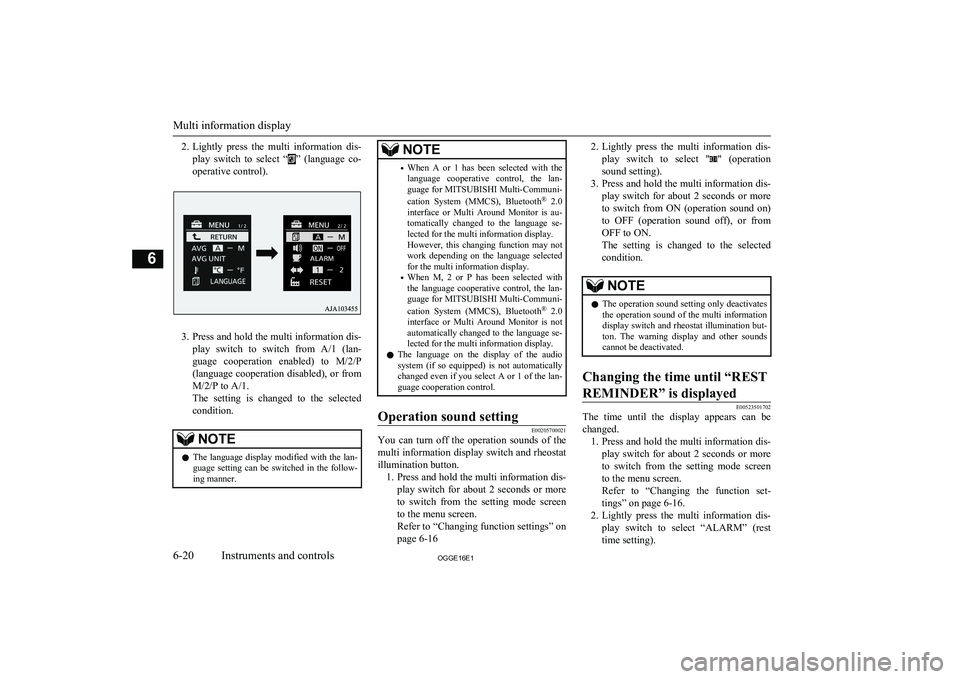
2.Lightly press the multi information dis-
play switch to select “
” (language co-
operative control).
3. Press and hold the multi information dis-
play switch to switch from A/1 (lan- guage cooperation enabled) to M/2/P
(language cooperation disabled), or from
M/2/P to A/1.
The setting is changed to the selected condition.
NOTEl The language display modified with the lan-
guage setting can be switched in the follow-ing manner.NOTE• When A or 1 has been selected with the
language cooperative control, the lan- guage for MITSUBISHI Multi-Communi-
cation System (MMCS), Bluetooth ®
2.0
interface or Multi Around Monitor is au- tomatically changed to the language se-lected for the multi information display.
However, this changing function may not
work depending on the language selected for the multi information display.
• When M, 2 or P has been selected with
the language cooperative control, the lan-
guage for MITSUBISHI Multi-Communi-
cation System (MMCS), Bluetooth ®
2.0
interface or Multi Around Monitor is not automatically changed to the language se-
lected for the multi information display.
l The language on the display of the audio
system (if so equipped) is not automatically changed even if you select A or 1 of the lan-
guage cooperation control.Operation sound setting
E00205700021
You can turn off the operation sounds of the
multi information display switch and rheostat illumination button. 1. Press and hold the multi information dis-
play switch for about 2 seconds or more to switch from the setting mode screen
to the menu screen.
Refer to “Changing function settings” on
page 6-16
2. Lightly press the multi information dis-
play switch to select "
" (operation
sound setting).
3. Press and hold the multi information dis-
play switch for about 2 seconds or moreto switch from ON (operation sound on)
to OFF (operation sound off), or from OFF to ON.
The setting is changed to the selected
condition.NOTEl The operation sound setting only deactivates
the operation sound of the multi information
display switch and rheostat illumination but- ton. The warning display and other soundscannot be deactivated.Changing the time until “REST
REMINDER” is displayed
E00523501702
The time until the display appears can be changed. 1. Press and hold the multi information dis-
play switch for about 2 seconds or more to switch from the setting mode screen
to the menu screen.
Refer to “Changing the function set-
tings” on page 6-16.
2. Lightly press the multi information dis-
play switch to select “ALARM” (rest time setting).
Multi information display
6-20OGGE16E1Instruments and controls6